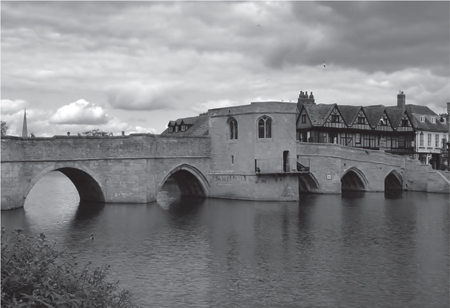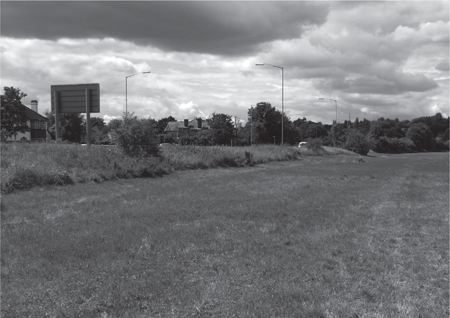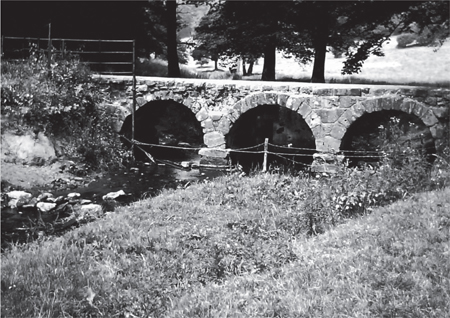The Medieval English Landscape, 1000-1540 (23 page)
Read The Medieval English Landscape, 1000-1540 Online
Authors: Graeme J. White

Bridge-building proliferated in England from the ninth century onwards, mostly in response to quickening trade and the growing demand from horse-drawn carts for safe and dry river crossings. Bridges at London, Rochester (Kent), Chester, Huntingdon, Cambridge and Nottingham, most with Roman forerunners and all in existence at important river crossings by the early tenth century (notwithstanding many subsequent replacements), appear to have been the result of royal initiatives and in every case an obligation was placed upon their associated shires to contribute to their upkeep: in Chester, for example, Domesday Book specifically mentions that ‘for the repair of the city wall and the bridge, the reeve used to call out one man to come from each hide in the county’ on penalty of a prohibitive £2 fine to be imposed on the lord of any man who did not come.
35
However, most medieval bridge construction, and their upkeep thereafter, relied on individual generosity, spurred by a mixture of self-interest and altruism often laced with a sense of pious duty:
over 100 bridges in medieval England had chapels built on and adjacent to them, mostly as chantries so that prayers could be said for benefactors. Similar considerations applied to causeways, usually over flood-plains leading to bridges, for which the same Old English word
brycg
was sometimes employed. About 1130, Alexander Bishop of Lincoln was given permission by Henry I to build a new bridge at Newark-on-Trent (Nottinghamshire), clearly as part of a concerted effort to develop an urban centre here, since he also built a castle and obtained a royal grant of a five-day fair; his initiative led to a permanent diversion of the Great North Road away from Ermine Street so as to cross the Trent at Newark, as the A1 still does today. It was also in Henry I’s reign that Ramsey Abbey is thought to have built a new bridge over the River Ouse in Huntingdonshire in order to encourage access to their market and fair at St Ives; its fifteenth-century successor, complete with chapel, still stands (
Figure 16
).
36
Beyond this, the provision of bridges frequently relied on bequests in wills and special fund-raising efforts from the sale of indulgences, which remitted the penance due following confession of sins: in 1479, for example, the Archbishop of York granted 40 days’ indulgence to anyone who contributed to a new bridge – the equivalent of the modern M6 Thelwall viaduct – over the ‘very great and swift river’ Mersey near Warrington, which was having to be built afresh.
37

Figure 16: St Ives Bridge (Huntingdonshire)
. A River Ouse crossing was established here when a new market-town was developed in the twelfth century, though the present bridge, with its chapel, is early fifteenth century (and the rounded arch dates to 1716). The previous settlement, Slepe, is marked by the church some 500 metres north-west of the bridge.
A common problem was that bridges, once built, were left without adequate arrangements for their ongoing maintenance. An enquiry in 1350 into responsibility for the upkeep of Egham causeway in Surrey, which led from the town of Egham to the bridge of Staines and was also a flood defence, found that it had originally been built and kept in repair during Henry III’s reign by Thomas of Oxford, at his own expense, but that there had been no provision for its upkeep thereafter. By 1385 the causeway was found to be ‘so destroyed and broken that the loss of all the adjacent country is to be feared,’ so the sheriff of Surrey issued a public proclamation ‘that all persons, ecclesiastical as well as secular, shall each, according to the extent of his holding, cause the same to be repaired with all haste.’ Thereafter, the crown made various grants of ‘pontage’ to named individuals, empowering them to levy tolls, and the causeway survives to this day (
Figure 17
).
38
Elsewhere, we find that from the early eleventh to the late fourteenth century – when responsibility passed instead to a charitable trust – the upkeep of the bridge over the River Medway at Rochester on the London to Dover road was vested in a series of landholders within the lathe of Aylesford, an administrative subdivision of Kent, who each had a stake in particular arches: the Bishop of Rochester was responsible for the first arch and its piers, the king for the fourth, the Archbishop of Canterbury for the fifth and ninth, and various manors in and around Gillingham for the remainder. This had the obvious disadvantage that the bridge would be of variable quality, but at least responsibility for this important crossing did not rest on one source alone.

Figure 17: Egham Causeway (Surrey)
. Originally built through an individual’s generosity in the mid-thirteenth century, the causeway was intended to carry east-west traffic crossing the River Thames at Staines and also to protect Egham if Runnymede (to the right) was flooded. The Egham bypass was opened along this extension to the causeway in 1935.
Another form of maintenance was through alms given to a hermit living on or near the bridge who was expected to keep it in repair, such as John ‘Leper’ who was authorized by the town of Oxford in 1377 to maintain the Grandpont over the River Thames. William Langland’s late-fourteenth century poem
Piers Plowman
criticized those who ‘paraded as hermits for the sake of an easy life’ but at least some of these men could alternatively be described as ‘professional bridge-wardens’. Many claimed to live by the thirteenth-century papally approved
Rule of St Paul
, which enjoined them ’to avoyde idleness … and to repair ways and brigges to youre power’ and were subject to formal appointment processes: in 1423 the mayor of Maidenhead presided over an installation ceremony at which the new hermit, Richard Ludlow, swore to keep away from taverns and spend all he received as gifts, beyond basic sustenance, on the repair of the town’s bridge and roads. As a variant of all this, in 1457–58 a circular went out from the mayor and governing body of Nottingham soliciting alms for repair of the town’s bridge, with a promise that the priest at the chapel on the bridge would celebrate divine service daily for the benefit of all who contributed.
39
So when the Statute of Bridges of 1531
lamented the fact that ‘decayed bridges’ were liable to ‘lie long without any amendment to the great annoyance of the King’s subjects’ and enacted that, unless an alternative obligation could be demonstrated, maintenance must always be the responsibility of the corporate town or shire within which the bridge stood,
40
it was arguably giving a misleading impression of the efforts made over the previous centuries to keep bridges in repair. Medieval engineers and those who engaged them have left us perhaps 200 bridges still functioning in England today and – like roads – they were maintained in a state sufficient to allow them to serve their society reasonably well.
In considering the structure of medieval bridges, we must of course acknowledge that many minor crossings serving packhorse routes would have been by ford or by the use of modest structures which rarely survive: tiny narrow arched bridges such as Bow Bridge near Furness Abbey (Cumberland) (
Figure 18
) or simple stone slabs, to create a clam bridge (with one span) or a clapper bridge (with two or more), like Postbridge clapper over the East Dart River on Dartmoor. Among more elaborate structures, timber was favoured for both bridges and causeways in the pre-Conquest period and although less durable than stone it offered a cheaper building material; accordingly, wooden bridges continued to be erected throughout the medieval period. Stratford-upon-Avon had a timber bridge until the end of the fifteenth century and in 1540 the majority of bridges over the Thames were still built of wood. However, stone was already in use by the end of the eleventh century, sometimes in conjunction with timber superstructures carrying the roadway but increasingly as the exclusive building material. There are a few examples of medieval bridges built in brick (as at Mayton Bridge, Norfolk over the River Bure) or of brick mixed with flint and stone (as at Moulton Bridge, Suffolk, over the Kennett), but these are exceptional: small, late and almost entirely confined to East Anglia.
41

Figure 18: Packhorse Bridge, near Barrow-in-Furness (Cumberland)
. This late fifteenth-century ‘Bow Bridge’ over the Abbey Beck, 3.2 metres wide, is a rare survival of the type of modest crossing widespread in medieval times. It gave the monks of nearby Furness Abbey access to a mill but also served an important packhorse route to the coast.
From the many surviving examples of medieval stone bridges, it is possible to see some technological development over the centuries. Similar techniques were used for the construction of arches as were employed in ecclesiastical buildings, and the same masons may sometimes have worked on both – as at Durham where Bishop Ranulf Flambard’s new stone bridge over the Wear in the early twelfth century was built at the same time as the cathedral nave, or at Chelmsford in 1372, where the rebuilding of Moulsham Bridge over the River Can was entrusted by the Abbot of Westminster to Henry Yevele, also responsible for remodelling the naves of Canterbury Cathedral and Westminster Abbey. It is no surprise, therefore, that bridge design mirrored that found in churches, with the semi-circular arches of the twelfth century – such as those within the Exe Bridge in Exeter, England’s earliest surviving stone bridge (albeit disused and incomplete) – giving way to pointed ones thereafter. Pointed arches allowed spans to be varied in width
so that piers could rest wherever the firmest foundations within the river were found, while allowing a level road surface to be maintained above. A further advance came in the form of segmental arches – rounded but less than a full semi-circle – which were introduced in the fourteenth century. These presented a flatter profile and allowed broader spans which caused less interference to river traffic. Good examples of pointed-arched bridges are those at Bakewell (Derbyshire) of about 1300 and at Huntingdon, rebuilt at various dates during the fourteenth century. Farndon (Cheshire), dating to 1339, and the fifteenth-century bridges at Ludford (in Ludlow, Shropshire) and also at Wadebridge across the Camel demonstrate segmental arches. All include projecting triangular-shaped piers which served to deflect flowing water away from the uprights and allowed refuges for pedestrians part way across.
A further dimension to all this was the greater boldness of engineers in the north of England when it came to the height and spans of the arches. The late-fifteenth-century stone bridge at Bideford (Devon) uses no less than 24 arches to cross the River Torridge, and there are similar examples of the use of multiple arches at roughly contemporary structures at Barnstaple (also in Devon) and Stratford-upon-Avon. But in the northern uplands long low bridges like these would have been vulnerable to flash floods and river surges, so fewer piers and greater arches were favoured: as at the late-fourteenth-century Devil’s Bridge at Kirkby Lonsdale (Westmorland), with two of its three arches having spans in excess of 16 metres; the Twizel Bridge over the River Till in Northumberland, built about 1500 as a single arch with a span of around 30 metres; and the Piercebridge over the Tees first noted by Leland, composed of three arches, the central one with a span of some 22 metres. With its precisely cut masonry and skilful use of several arch rings (counter arches) to support the superstructure, this last example has been described as ‘the climax of medieval bridge design’.
42
In company with some of the other bridges listed here, it deserves to be ranked alongside great castles and churches among the best illustrations of medieval structural engineering.